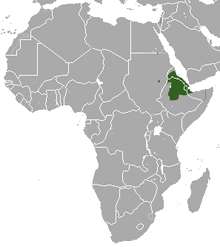| Abyssinian genet | |
|---|---|
_Genetta_abyssinica.jpg) | |
| Scientific classification | |
| Kingdom: | Animalia |
| Phylum: | Chordata |
| Class: | Mammalia |
| Order: | Carnivora |
| Suborder: | Feliformia |
| Family: | Viverridae |
| Genus: | Genetta |
| Species: | G. abyssinica[1] |
| Binomial name | |
| Genetta abyssinica[1] | |
 | |
| Abyssinian genet range | |
The Abyssinian genet (Genetta abyssinica), also known as the Ethiopian genet, is a genet species native to Ethiopia, Eritrea, Somalia, Sudan, and Djibouti. It is listed as Data Deficient on the IUCN Red List.[2] It is one of the least-known genet species.[4]
Characteristics
The Abyssinian genet has a shortened face, short legs and a moderately long tail, which is nearly as long as head and body. Its short, coarse fur is pale sandy in colour with five longitudinal black stripes on the back. The spots on the lower flanks are also distinctly elongated, resembling stripes rather than spots. The tail is marked by at least seven pale rings, separated by seven or eight narrow black rings and has a dark tip. It is also distinguished by the lack of hair between the metacarpal pad and digital pads on the forepaws. It's heady-to body size is 40 to 50 cm (16 to 20 in) with a 40 to 45 cm (16 to 18 in) long tail. The dental formula is: 3.1.4.23.1.4.2[5][6]
Distribution and habitat
The Abyssinian genet inhabits coastal plains, Afromontane grasslands, and mountain moorlands.[7] In Ethiopia, Abyssinian genets were observed up to 3,750 m (12,300 ft) in the Abune Yosef massif.[8]
Threats
The population is likely being reduced due to habitat fragmentation, as many areas with historical records have been turned into croplands.[4] Prior to the Second World War the skins of Abyssinian genets were recorded for sale in markets in Addis Ababa market, it is unknown whether there is still a market for the skins of this species. In general this species is too poorly known to properly assess its conservation status.[2]
References
- ^ Wozencraft, W.C. (2005). "Genetta abyssinica". In Wilson, D.E.; Reeder, D.M (eds.). Mammal Species of the World: A Taxonomic and Geographic Reference (3rd ed.). Johns Hopkins University Press. p. 554. ISBN 978-0-8018-8221-0. OCLC 62265494.
- ^ a b c Gaubert, P.; Duckworth, J.W. & Do Linh San, E. (2016). "Genetta abyssinica". IUCN Red List of Threatened Species. 2016: e.T8994A45198149. Retrieved 22 October 2018.
- ^ Rüppell, E. (1835). "Viverra abyssinica". Neue Wirbelthiere zu der Fauna von Abyssinien gehörig. Frankfurt: Siegmund Schmerber. pp. 33–35.
- ^ a b Balakrishnan, M.; Afework, B. (2008). "A road kill of the Ethiopian Genet Genetta abyssinica along the Addis Ababa–Dira Dewa Highway, Ethiopia". Small Carnivore Conservation. 39: 37–38.
- ^ Coetzee, C. G. (1977). "Order Carnivora. Part 8". In Meester, J.; Setzer, H. W. (eds.). The mammals of Africa: an identification manual. Washington, DC: Smithsonian Institution Press.
- ^ Kingdon, J. (1997). The Kingdon Field Guide to African Mammals. Princeton University Press. p. 270. ISBN 069111692X.
- ^ Gaubert, P. (2013). Genetta abyssinica Ethiopian Genet. In: J. Kingdon and M. Hoffmann (eds.) The Mammals of Africa. V. Carnivores, Pangolins, Equids and Rhinoceroses, pp. 216–218. Bloomsbury, London, UK.
- ^ Diaz Behrens, G. and Van Rompaey, H. (2002). The Ethiopian Genet, Genetta abyssinica (Rüppell 1836) (Carnivora, Viverridae): ecology and phenotypic aspects. Small Carnivore Conservation 27: 23–28.
